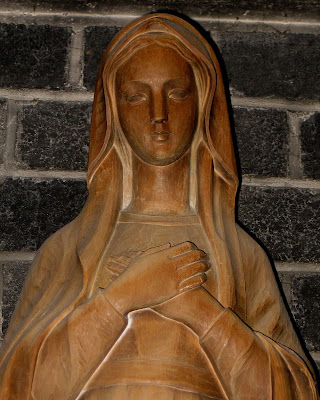Cynewulf
The poet Cynewulf had influence on other writers, notably J.R.R.Tolkien.
Tolkien was influenced by the following couplet from Christ I (lines 104-5), which inspired his portrayal of Middle-earth and his character Earandil (1)
"Eálá Earendel engla beorhtast
Ofer middangeard monnum sended."
Translated,
"Hail Earendel brightest of angels,
over Middle Earth sent to men."
In describing Mary as maegoa weolman (445) [the flower of maidens], he establishes that, though she was but a simple girl among all other girls, she achieved so bountiful a flowering of her potential that it raised her above all other women.
By juxtaposing the term maerre meowlan (446) [of the glorious Virgin] with maegoa weolman, Cynewulf emphasises the contrast implicit in the elevation of a simple girl to a woman of majesty once God's choice of a Mother for His Son fell upon Mary.
The Christians of Cynewful's era appear to have regarded God's choice of Mary to bear the Messiah an exalted mark of distinction.
Christ I
As may be expected in view of the major role played by Mary in the Incarnation of Jesus, Christ I - The Advent Lyrics devotes a great deal of space to her praise.
The poet introduces her with a spontaneous simplicity, at once poignant and naive, as he writes:
35
... Wæs seo fæmne geong,
mægð manes leas, þe he him to meder geceas;
þæt wæs geworden butan weres frigum,
þæt þurh bearnes gebyrd bryd eacen wearð.
Nænig efenlic þam, ær ne siþþan,
40
in worlde gewearð wifes gearnung;
þæt degol wæs, dryhtnes geryne
... the woman was young
a virgin free from sin whom he chose to be his mother
it came to pass without man's embrace
so that for the sake
of the child's birth the bride became pregnant
No woman's reward before nor since
in the world occurred in this way
it was kept secret God's mystery
The sensitivity with which the poet describes the Blessed Virgin's chastity;
þæt wæs geworden butan weres frigum (37), bears witness to the high premium Anglo-Saxon Christians put on purity and highlights the poet's own deep reverence for Mary of Nazareth.
In the second section of Christ I the poet formally observes all the proprieties involved in the matter of correct address, as he launches into a lofty panegyric in praise of Mary, reverently addressing her as follows;
Eala wifa wynn geond wuldres þrym,
fæmne freolicast ofer ealne foldan sceat
þæs þe æfre sundbuend secgan hyrdon,
arece us þæt geryne þæt þe of roderum cwom,
75
hu þu eacnunge æfre onfenge
bearnes þurh gebyrde, ond þone gebedscipe
æfter monwisan mod ne cuðes.
Ne we soðlice swylc ne gefrugnan
in ærdagum æfre gelimpan,
80
þæt ðu in sundurgiefe swylce befenge,
ne we þære wyrde wenan þurfon
toweard in tide. Huru treow in þe
weorðlicu wunade, nu þu wuldres þrym
bosme gebære, ond no gebrosnad wearð
85
mægðhad se micla. (71-85)
Hail, joy of women among wondrous hosts
fairest woman in all the world
of whom sea dwellers (ever) heard tell
teach us the secret coming down from the skies
how that conception was accomplished in thee
and thy baby's bearing without knowledge of man
as is (not at all) the custom of others.
Never in truth has such been heard
in days of yore to have occurred
that (which) by special grace thou didst receive
nor do we have reason to expect it to happen again
in days to come. Verily Truth in thee
truly resided, inasmuch as the glorious Lord
thou in thy bosom didst bear while nothing corrupted
thy virginity so glorious.
The poet calls on Mary of Nazareth to arece us þæt geryne: explain (to humanity) the enigma (74) of her conception of the Lord Jesus Christ and rejoices that God's Trust in her has been amply justified (82-85).
The connotation invoked by the claim that treow (82) weorðlicu wunade (83) passes beyond the conspicuous fact that God reposed confidence in her, as it suggests an Image of Christ, at once human and divine, Who in His Divine Capacity reclines in Mary's womb as a trustful and powerless infant.
As may be seen, the keynote of extant Anglo-Saxon Marian poetry was a solemn dignity, which indicates that writing was the province of an exalted, educated few, while the emphasis on religion appears to suggest that the writers were probably ecclesiastically educated and mostly clerics themselves.
Anglo-Saxon Marian Poetry
Extant Anglo-Saxon Marian poetry, though limited in volume when compared to the wealth of surviving mediaeval poetry in praise of Mary of Nazareth, is resonant and impressive, testifying that the Anglo-Saxon poet experiences a profound sense of reverence for the role played by Mary in the Life of her Son the Redeemer.
His generation unselfconsciously practises hyperdulia as it becomes the first to call her blessed in the English idiom.
While he does not claim for her any fallacious divine powers of her own, his faith in her power to mediate with God is practically unlimited.
Prelude to Mediaeval Marian Poetry
Anglo-Saxon Marian poetry has been dealt with in the recent blog posts as a prelude to mediaeval Marian poetry, which by comparison is considerably more voluminous but far less solemn in its approach.
Though in its ecclesiastical solemnity the Anglo-Saxon's poetry is less exuberant and spontaneous than much of the work of his mediaeval succesors, the extant corpus nevertheless endorses, for the Anglo-Saxon era and the centuries which will succeed it, Mary's prophecy that all generations will call her blessed in celebration of the manifestation of God's miraculous power in her life on account of her obedience to his call.
(1)
http://en.wikipedia.org/wiki/Christ_I
The Old English Poems Christ I - III http://www8.georgetown.edu/departments/medieval/labyrinth/library/oe/texts/a3.1.html




